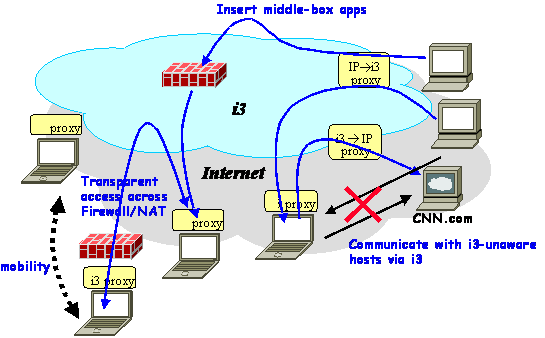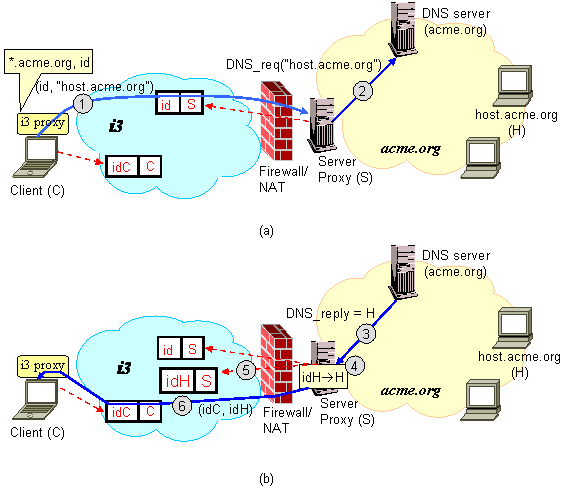Application Scenarios
Here we describe a few useful applications of i3 and the OCALA proxy. These
applications require no changes to the legacy applications,
operating systems, NATs or firewalls.

Connecting to home machines
Most users today have problems connecting to their broadband-connected
home machines from their workplace for two reasons:
- Changing IP address: Most ISPs change the IP address allocated to
the machine periodically, some more frequently than others, and this
is a hassle to most users trying to run some service on their host.
- NAT: A significant fraction of home routers also serve as NATs
for security reasons. In such a case, since the address allocated to
the host is essentially a locally valid address, it is not valid
externally. Also, enabling an incoming connection through the NAT,
requires special NAT configuration.
The first problem has to do with mobility, while the second
problem has to with combining disparate address spaces. The
solution using the i3 implementation is simple. The client
proxy can be run on the home host which can insert public triggers
under a dns name, say john.home.i3, in the Planetlab i3
infrastructure. Also, the remote machine also needs to run the client
proxy. Once this done, all access on the remote machine to
john.home.i3 will be redirected to the home machine. For
details of how the client proxy works see here.
Secure Intranet Access
For security reasons, many organizations today resort to the draconian
measure of setting up a firewall that filters outgoing connections and
does not allow any incoming connections. Such measures make
it hard for users to connect to their work machines from
elsewhere. The security administration is not to blame here: there is
no other feasible flexible alternative. The i3 implementation can be
used for this scenario.
A server proxy runs inside the organization and thus has unrestricted
to all the intranet machines. This server proxy is set up to
authenticate users connecting from home. This authentication requires
a simple key management system. The firewall is configured to allow
incoming access to the server proxy. This method offers a secure way
of allowing Intranet access.
The following figures illustrate how such application is supported
by i3. Consider a company, Acme, that wants to give access to
its employees to the services and the resources on the intranet. To
achieve this, Acme sets-up a machine S that runs the (see i3 server proxy module. The
server proxy maintains a trigger (id, S) where it can be
contacted by remote clients. Now, consider a remote client C
that wants to access host H, with the DNS name host.acme.org,
inside the firewall. Let (idC, C) be a trigger inserted by
client C. Then the following sequence of steps take place:
- Client C sends a DNS request for
host.acme.org. The i3 proxy running at C
intercepts this request and checks the configuration file
i3-proxy.xml (see here
for details) to see whether the request needs to be redirected, and if
yes, to what i3 identifier. In this case, the configuration
file indicates that all DNS requests for *.acme.org needs to be
redirected to identifier id, so the proxy encapsulates the DNS
requests and forwards it to S via trigger (id, S) (see
step 1 in Figure (a)).
- Upon receiving the DNS request, the server proxy forwards it to
the local DNS server (step 2, Figure (a)). When the server
proxy receives the reply back (step 3, Figure (a)), it
allocates an identifier idH for the host, and inserts the
corresponding trigger (idH, S) in i3 (step 5,
Figure (b)). At the same time the server proxy stores the mapping
idH->h (step 4, Figure (b)). This mapping is used to
forward all packets with identifier idH to host
H. Finally, the server proxy sends identifier idH to
client C via the client's trigger (step 6, Figure
(b)). Once it gets this identifier, the client can use it to
communicates with host H.
 Note that the functionality provided by the setting in the figure
above is similar to the functionality provided by a Virtual Private
Network (VPN). However, our solution has two advantages over VPNs:
Note that the functionality provided by the setting in the figure
above is similar to the functionality provided by a Virtual Private
Network (VPN). However, our solution has two advantages over VPNs:
- In a VPN, once a client connects to an intranet, it will get
an IP address on that intranet. But this means that if the client is
infected, the client can potentially infect all machines on the
intranet. To avoid this problem, many of the existing VPN solutions
use firewalls to restrict the access of the remote clients, which can
defeat the original propose of the VPN.
In contrast, our solution makes it hard for an infected client to
infect other machines on the intranet, since a virus or worm cannot
use address scanning. This is because, as discussed here, the client proxy returns to
the application a fake IP address that has only local meaning; this
address has no relation with the real IP address of the
destination. Furthermore any attempt of address scanning in the range
used to allocate fake IP addresses can be easily detected as the
client proxy knows exactly the fake addresses that are in use.
- A client can access multiple intranets at the same time. This is
not possible in existing VPN solutions since a client can acquire only
one IP address at a time.
Middle-box Applications
There are several interesting middle-box applications today: intrusion
detection systems (like Bro), spam filtering (an application-level
middle-box) etc. They however require access to the edge router of an
organization etc, which is not always feasible. To make the deployment
of middle-boxes more convenient, the routing flexibility of i3
can be used. The client proxy can be configured to redirect traffic
through, say, a intrusion detection system, which would then monitor
traffic. The key point to note here is that intrusion detection system
can be running on any machine, in fact, it can even be running on
different machines at different times. An implementation of the client
proxy which allows re-direction through an intrusion detection system
is in the works. This implementation will allow the user to interpose
any middle-box to monitor the traffic of willing users (who run the
client proxy).


